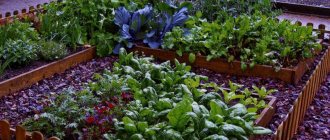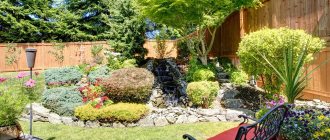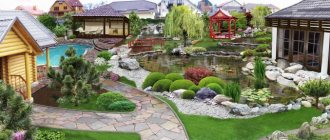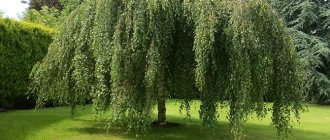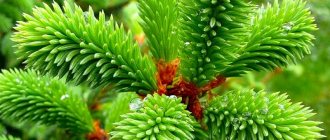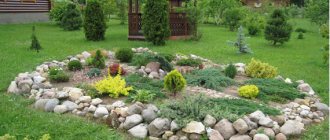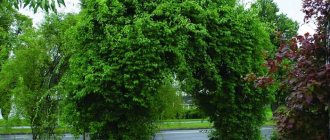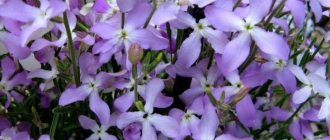There are simply no gardens that are ideal in terms of terrain and conditions. Each site has its own disadvantages - either elevation changes, specific soil characteristics, or areas with too high groundwater levels. If there is a problem area in your garden where the soil is swampy or waterlogged, do not rush to install powerful drainage and change the landscape using artificial methods.
You have a unique chance to arrange a truly unusual object - a wet flowerbed and a picturesque corner with moisture-loving plants. These are unique crops with luxurious leaves and unique flowering.
Flower garden in a damp area. © vcrown
Selection of suitable plants
There are no ideal summer cottages. On some there is increased dryness or excess moisture, on others there are unusual soil features, on others there are elevation changes, on others groundwater lies near the surface. If the soil on the site is swampy or too damp, it is quite possible to do without powerful drainage. To preserve the natural landscape, you need to plant suitable plants on it. Moisture-loving trees and shrubs delight the eye with luxurious foliage and lush flowering. Experts who professionally engage in landscape design say that there are simply no bad areas for them. No matter what features the site has, it always provides rich opportunities for the implementation of the most daring plans. It is only important to choose an option that meets specific conditions. In waterlogged areas, you can create a “wet garden” by planting trees and shrubs that can tolerate a lack of oxygen in the soil.
Spreading rosemary
In nature, the spreading rush can be found in grass swamps, damp banks of reservoirs, damp and swampy meadows, and along river banks. Its spiral shape is very impressive.
Juncus effusus 'Spiralis', photo from Buy Rare Seeds site
Juncus effusus 'Spiralis' is a perennial leafless grass with a short creeping rhizome and spiral-shaped stems, grows up to 45 cm in height; can grow up to 60 cm in width.
Features of cultivation
This unpretentious, spectacular grass will certainly decorate your “swamp” and add a kind of exoticism. It is better to plant it in a wide container, which is then placed in a semi-shaded or bright place (digged into the ground to a depth of 5-10 cm).
Crops for areas with high humidity
Moisture-loving plants are divided into two classes:
- beautifully flowering with attractive leaves;
- deciduous and decorative with inconspicuous flowering.
There are lovers of damp soil among both annual and perennial plants. Most of these crops belong to the group of trees and shrubs (for example, viburnum, serviceberry, hydrangea) or to the herbaceous class of perennial plants that can live in one place for several decades. Such varieties grow naturally in shallow waters, swamps, and water bodies. They are also perfect for artificial plantings in summer cottages.
Moisture-loving shrubs and trees have the ability to drain the soil around them. To eliminate excess moisture in a summer cottage, you can plant a birch tree, which, after reaching maturity, drains the soil within a radius of about 10 meters. Moisture-loving trees also include elderberry, maple, and willow. Examples of moisture-loving shrubs are silver currant, viburnum, cranberry, etc. Fruit-bearing bushes can be planted in a small summer cottage with high soil moisture. However, it must be taken into account that even moisture-loving plants do not bear fruit in overly swampy and damp soil.
Monstera
Another moisture-loving plant from the Araceae family. A large tropical liana came to us from the tropical forests of South America. In home growing conditions, the delicious monstera is most often used. This plant needs moist and warm air. In summer, the flower needs frequent and abundant watering, but in winter, the amount of water should be significantly reduced. In addition, it is necessary to constantly spray the plant and wash the leaves with warm water.
Monstera is an unpretentious plant; it can grow 5 meters in height. When growing it indoors, it can be quite difficult to achieve flowering. Greenhouse specimens delight with white flowers that look like a closed lily, and the edible fruits taste like a ripe banana.
Swamp Rose
Swamp rose is an erect, spreading bush up to two meters high. It constantly produces young shoots and grows quickly. This shrub is also known as Pennsylvania rose. It comes from North America. It lives on the shores of reservoirs and in wetlands, as well as in ravines. Prefers partial shade and bright sunlight. The purple-reddish shoots have many thorns, and the edges of the pubescent dark foliage have teeth. The appearance of a picturesque openwork crown is complemented by inflorescences of several small flowers. The bush emits a pleasant aroma. During the summer, the color changes from pink to bright orange. Flowering occurs in July-August.
Swamp rose requires constant care, including timely removal of young shoots and annual pruning of old branches. This crop is suitable for creating a spectacular accent. It stands out brightly against the background of decorative foliage plants.
Common Podbel
A swampy lowland area can be a real peat bog, in which there is a perfect place for whitewash. In world floriculture, the priority name for this evergreen shrub is andromeda; among the people - swamp rosemary, obtained due to the similarity of the leaves.
Common Podbel, photo site liste_photos and alba, photo site Bidorbuy
Common Podbel (Andromeda polifolia) is a variable (very variable) evergreen semi-prostrate shrub from the Heather family (Ericaceae), up to 40 cm high, up to 60 cm wide. It comes from Northern Europe. Young shoots are reddish, old shoots are dark gray. The leaves are small, 1.5-3.5 cm long, linear. The flowers are light pink, up to 3 cm in diameter, pitcher-shaped, like small inflated balloons, very similar to the flowers of our small-fruited strawberry, collected in loose apical umbrellas; bloom from spring to early summer. Decorative varieties:
- 'Alba' - 15 cm high, white flowers;
- 'Compacta' - 30 cm high, 20 cm wide, wide, shiny leaves, pink flowers;
- 'Macrophylla' - 5-15 cm high, 25 cm wide, wide leaves, up to 3 cm long, deep pink or white flowers;
- 'Nikko' - 20-25 cm high and wide, round in shape, gray-green leaves, up to 2.5 cm long, pale pink flowers.
Features of cultivation
In nature, polyfolia grows in swampy larch forests and woodlands, in moss swamps, so it needs shady, moist places with loose, permeable, acidic soil (pH 5-4.5). Please note: the places where you place the podbel should not be allowed to dry out. Winter-hardy in central Russia (in Yakutia it grows in mountain swampy tundras). Propagated by seeds and apical cuttings. Like all Ericaceae, the plant is mycorrhizal: it requires the hyphae of certain fungi. It is important! The common pommel ! And the peat bog is a real paradise for the recently fashionable plants of the Heather family: rhododendrons, blueberries, and andromeda. Along the banks of drainage ditches, it is good to plant irises, calligraphy, marigold - they bloom in the first half of summer, and so that flowering continues into August - loosestrife, susak, loosestrife.
Meadowsweet
Under natural conditions, meadowsweet, also called meadowsweet, grows in flooded meadows and swampy forests. In a cultivated area it requires approximately the same conditions. In June, the meadowsweet blooms into white lush laces. Although in other months this plant looks modest, its hardiness and beauty have made it very popular among gardeners.
The most common varieties are those with white flowers, but there are also varieties with pink flowers. The feathery leaves form a majestic backdrop for the paniculate and corymbose inflorescences. Most of all, gardeners value meadowsweet and Korean meadowsweet, from whose pink buds white flowers bloom. Withered inflorescences should be cut off, and the bushes should be divided and replanted every 5-6 years.
Meadowsweet is planted on the banks of natural and artificial reservoirs, in landscape areas, and on forest edges. It loves sunlight, but easily adapts to partial shade. Watering is required only when the soil dries out.
Domestic green giants
Sometimes you want to see a tub with a large plant in an empty corner. Large moisture-loving indoor plants will survive well in such poor lighting. They will decorate the room and absorb carbon monoxide if they are provided with the usual conditions - moist soil.
The most popular monster plants:
- Monstera;
- palm trees
Monstera is a real giant among indoor plants. This is a South American vine that grows up to five meters. Green monsters often live in libraries, reception areas and foyers of various institutions. This is a plant with large dark green leaves that look like they have had large holes cut out of them.
Monstera needs plenty of moisture in summer; in winter it is satisfied with moderate watering. Leaves should be regularly wiped from dust, which serves as a good reason to take a break and communicate with nature.
Palm trees grow in the tropics, in both dry and very humid climates. They grow if watering is combined with spraying, because the leaves also absorb water. The ideal conditions for palm trees in northern latitudes are a greenhouse.
In your own winter garden with one palm tree in a pot or tub, you need to create a humid atmosphere. The plant is sprayed and trays with water are placed next to it. Place a damp cloth over hot batteries.
The most moisture-loving types of palm trees:
- Bamboo palm, or Hamedorea;
- Umbrella palm, or licuala;
- Fan palm or Livistona.
Kaluzhnitsa
Marigold is also known by the names "water snake" and "paddling pool", which reflects the penchant of this beautifully flowering perennial plant for damp, marshy areas. Dense, almost round leaves with a diameter of up to 12 centimeters grow on the branched stems of this crop. Attractive golden inflorescences that bloom in April-May give the plant a special charm. Marigold is used to create a spot of color in the foreground of the garden, to decorate a wet flower bed. The most popular among gardeners are the horned marigold, the multi-petalled marigold with golden flowers, and the marsh marigold.
In case of excessive growth, division of marigold is carried out every 3-4 years. This crop needs a lot of sun, but it can do with partial shade under trees with a not too dense crown.
When might you need a designer's help?
The design of the garden can be done by a designer.
He will assess the conditions of the location of the dacha, plan, select shrubs and trees, add indoor plants to pots, and advise on their care. In this case, even a swamp will become decorative, and an artificial reservoir will become a natural stream. By correctly selecting and arranging luxurious plants that are not afraid of damp places, even a problem area can be turned into a blooming, fragrant place that bears fruits and berries. What to consider when choosing plants
The only thing that is taken into account when choosing plants is resistance to moisture, frost, low oxygen concentration in the ground, and the ability to withstand flooding . As practice shows, a site that cannot be landscaped in a standard way has all the conditions for creating bright, unusual areas and places for relaxation. The assortment of trees, shrubs, and plants is extensive; you can display indoor flowers in flowerpots. Therefore, areas with high humidity are a chance to create unique decorative compositions, and with some effort you will get good harvests of berries and fruits.
Swamp spurge
The Euphorbiaceae family includes herbaceous plants, subshrubs, shrubs and trees. Swamp spurge stands out among them for its love of dampness. Under natural conditions, it grows in water meadows; in the garden it can tolerate short-term flooding. In landscape design, this crop is used to form a background for other plantings, create a textural accent, and is used to decorate ponds and decorate wet flower beds.
This perennial plant with a large cylindrical rhizome is characterized by unpretentiousness, but at the same time it is aggressive and toxic. Bare bluish shoots are decorated with narrow bright foliage. The inflorescences located on top have an inconspicuous appearance. After flowering is completed, pruning is performed to thicken the clumps. Once every 3-4 years, swamp spurge is rejuvenated by completely removing the above-ground part. For normal development of this crop, moist soil and a lot of light are required. For tall varieties you need to install supports.
Buzulnik
Large-leaved and spectacular buzulniks are one of the best garden landscape crops. Even a few buzulnik bushes can create the effect of a “wild” landscape, but the main advantage of this species is the ability to grow in almost any conditions.
Reaching a height of more than 1 m, buzulniki flaunt very massive leaves, sometimes up to 50 cm in diameter, which sit alternately on the shoots and form beautiful patterned clumps.
Buzulnik blooms in the second half of summer, decorated with beautiful and bright yellow-orange baskets of inflorescences with thin lingual flowers along the edge and often a convex core of tubular flowers in the center. The baskets are most often collected in brushes or scutes, rarely blooming individually. A scattering of fairly large yellow “daisies” seems radiant and very impressive.
Toothed buzulnik (Ligularia dentata). © Peter Hanegraaf
Use options: in large compositions, as a lush background or a massive center of wet flower beds and swamps, coastlines, in large groups, as a spectacular accent
Required conditions: partial shade or shade, moist to heavy and undrained moist or waterlogged soils; tolerates temporary flooding well
Features of care:
- loosening the soil in spring;
- mulching the soil in areas that are not too wet;
- gartering inflorescences as needed and pruning as they wilt;
- cutting off above-ground parts in late autumn;
- protection from slugs.
Buzulnik, or Ligularia, or Ligularia. © Leonora Enking
Loosestrife
Loosestrife is a perennial plant with straight shoots that form clumps 70-80 centimeters high. This culture is shade-tolerant, but loves sunlight, in which it quickly grows into a large bush, or more precisely, into a clump. Loosestrife tolerates harsh winters well and does not need shelter during the cold season. It has a powerful but shallow root system that tends to cover a large area. For this reason, to preserve the beauty of the flower garden, it is necessary to regularly remove excess parts of the bush. When growing creeping varieties, it is necessary to control their growth; when growing erect varieties, remove the inflorescences and hill them up.
The best conditions for growing loosestrife are moderately humid, although it does well in waterlogged areas. Loosestrife blooms from May to August. At this time, white, pale yellow or pink inflorescences bloom. After flowering is completed, the faded parts are cut off, due to which re-blooming begins, which is more abundant.
Platycerium
The moisture-loving plant, whose name translates as “flat horn” or “deer horn,” has a rather exotic appearance. The appearance of its leaves really resembles deer antlers.
Platycerium needs constantly warm and humid air. It is best grown hanging on bark wrapped in moss. It is also possible to grow in ordinary flower pots, but you need to use an orchid substrate, which should be constantly moistened. Provide it with good protection from drafts and drying out. An important point in care is to be careful with the surface of the leaves - the small villi that provide access to moisture to the plant are very sensitive, so mechanical influences are contraindicated. It is strictly forbidden to wipe the leaves!
Thyroid darmera
Thyroid darmera is a herbaceous perennial plant with huge leaves. It tolerates cold well in winter. Darmera does not shoot underground shoots; the bush grows evenly. The knobby, powerful, thick rhizome of the plant has a diameter of 6 centimeters.
With the help of this crop, the coasts of reservoirs and large wetlands are decorated; it is used for arranging damp flower beds. Green leaves with veins and grooves are perfect for this purpose. Throughout the season, streaks and purple spots appear on them. Flowering occurs in April-May, before the leaves appear. The beauty of delicate pink flowers is emphasized by unusual purple stems. The best soil for dharmera is one with variable levels of swampiness. She doesn't really like sunlight and prefers partial shade. If the bush grows excessively, it is divided. It is recommended to trim the flower stalks. Fertilizing is done every spring. The most common variety “Nanum” has a height of up to 50 centimeters.
Begonia
One of the most common flowers, which is both moisture-loving and drought-resistant. The plant is loved by gardeners due to its long flowering period. Decorative deciduous and decorative flowering varieties of begonia are used for growing indoors. Some varieties are able to retain their original leaves throughout the year, but the most beautiful are tuberous begonias, which have luxurious flowers.
These plants are completely unpretentious in care and resistant to many diseases. It is advisable to place the flower pot in a well-lit place with diffused sunlight. Water the plant as the top layer of soil dries. To maintain optimal soil moisture, the flower pot can be placed in a tray with wet peat. On hot summer days, it is advisable to spray begonia with a spray bottle.
Swamp calamus
Under natural conditions, marsh calamus grows near lakes, rivers and swamps. Gardeners also plant it in their summer cottages. This hardy plant has long, bright green leaves with frilled edges. It looks great in wetlands. Calamus loves sunny open areas with fertile, silty, floodable soil. It requires early flowering neighbors who close the clumps in early summer. This crop needs to be constantly weeded; if it grows excessively, the clumps must be separated. The most popular variety at present is not the marsh calamus, but the garden variety of this plant with white and cream stripes, called “Variegata”. Its striking coloring and relatively low height form a pleasant background and make a strong impression thanks to its unusual appearance.
Himalayan honeysuckle
A moisture-loving and unpretentious shrub. The plant does not require any special care. It is quite easy to grow. The culture has arched branches, against the green background of which the purple inflorescences look quite impressive. Himalayan honeysuckle looks best against the background of white turf and near ponds, in the surface of which the shoots of bushes are reflected.
General recommendations for moisture-loving trees and shrubs
Moisture-loving shrubs and trees grow best in soil rich in nutrients. Therefore, to create favorable conditions for them, the acidity of the soil should be reduced and a nutrient substrate should be added to it. In addition, such an area must be constantly monitored, preventing the soil from drying out. This is especially true in the summer months, when it does not rain too often. Although many moisture-loving plants can tolerate short-term droughts, it is advisable to provide them with water in a timely manner. The best conditions for them can be provided on a well-lit coast of a reservoir. They can be planted on the borders of a summer cottage on the side of a pond or lake as a hedge. Willow and alder have decorative properties throughout the year due to the noble pattern of the bark. In different types of willow, the bark also has different colors.
In areas where the soil remains wet for a long time, plants should not be planted in late autumn, since the soil in such areas quickly freezes at this time. It is best to plant them in spring or early summer, when the soil is warm enough.
Which shrubs would be a good choice when decorating a garden plot?
Hedges formed from moisture-loving shrubs look attractive and are beneficial, creating a natural atmosphere and providing coolness in hot weather.
It is best to plant shrubs in the fall on the border in a lowland, near a pond, to divide the garden into zonal areas. Deciduous or coniferous species of moisture-loving bushes are suitable for this. How to choose the right moisture-loving shrubs
To do this, it is worth choosing the most suitable dacha according to the owner’s preferences, which will fit into the surrounding landscape. You need to familiarize yourself in detail with the characteristics of each species, know about flowering time, height and size of the plant. Dimensions are important in order to plant shrubs at the correct distance.
Characteristics of some types of shrubs
Gardeners prefer
berry yew . Drained, moisture-permeable soil is suitable for it, so it should not be planted in places where water stagnates. Such conditions are suitable for western thuja , whose dense growth creates a dense hedge. Privet and boxwood , which are popular among landscape designers, are considered to be lovers of moisture Many other shrubs: fieldfare, sea buckthorn, elderberry viburnum, and Hungarian lilac thrive in moist soils.
Which moisture-loving plants do designers choose for planting in wet areas?
Among the perennial moisture-loving flowering plants that love sunny places for garden design, you can choose:
- valerian;
- blood red heuchera;
- geranium;
- swamp gladiolus;
- irises;
- forget-me-not;
- violet;
- periwinkle or others.
You can also decorate the banks of a pond, stream or artificial reservoir with plants. The list of plants is extensive, these are:
- calamus;
- veronica;
- St. John's wort;
- marigold;
- reeds and many others (you can select plants suitable for such areas).
Coastal plants will be able to tolerate different weather conditions. They captivate with their splendor and brightness of leaves and flowers. With the help of climbing varieties, it is convenient to hide, smooth out steep banks, and decorate with flowerpots with indoor flowers.
Plum
For those who want to drain the area and get a wonderful harvest of ripe berries as a bonus, we can recommend planting plums in their dacha.
Moreover, when buying a seedling in a nursery or on the market, you need to pay attention to the rootstock. After all, it is the roots of the plant that must penetrate deep into the soil and take excess water from it.
Experts advise purchasing recyclables. This subspecies of plum will drain the area as quickly and without problems as possible.
You need to plant a tree using a certain technology. Drainage must be placed in the hole. Sufficiently large stones that need to be mixed with soil are suitable. The depth of the planting hole must be at least 80 cm.
Creating a sand cushion
The quality of the soil and its level of breathability can be increased by mixing it in equal proportions with sand. Fertilizing with humus will allow you to grow berries and vegetables with a good harvest.
The only limitation in the use of this method is that it is effective with a small volume of water on the surface.
List of plants to grow in peat or marshy areas
Despite the fact that many are confident that the plan will fail, there are plants that can grow in an acidic environment:
- potato;
- greenery.
If you reduce acidity by neutralization, plant vegetables :
- beets;
- carrots;
- white cabbage;
- strawberries;
- pumpkin
If you decide to plant berry bushes , then feel free to plant:
- raspberries;
- cranberries;
- rose hip;
- blueberries;
- currants;
- blackberries.
You can also try growing trees
- plum;
- cherry;
- apple trees
From decorative representatives:
- birch;
- fir;
- cedar;
- viburnum.
For a flower bed on peat bogs, you can safely plant flowers :
- hydrangeas;
- rhododendrons;
- heather;
- ferns;
- Erica;
- chrysanthemums.
Blueberry
In many regions it is considered a rare berry. More often it can be found in the wild. There is a growing interest among gardeners in growing promising varieties on their plots. With proper care, you can have a good harvest of healthy berries.
Blueberry varieties
- Tall varieties do well as hedges. Their bushes are branched, the berries have an intense blue or dark blue color.
- Low-growing blueberries bloom luxuriantly in spring, delighting with excellent yields and neat bushes.
- Southern varieties were developed through hybridization for cultivation in arid climates.
Device
Safety valve disassembled
The design of the safety valve in the boiler is simple. But to install and repair it, you need to know what it consists of. Externally they resemble plumbing tees. This form is not simple, because the element simultaneously serves:
- shut-off valve;
- check valve;
- safety valve.
There are three types of safety valves:
- for containers less than 50 l;
- for containers from 50 to 200 l;
- for containers from 200 l.
Classic “home” water heaters are equipped with valves from groups 1 and 2. They are not demanding and cheap.
A safety valve is a pair of cylindrical fragments that have a common plane. The component fragments vary in size. The larger one contains a poppet valve, which is pressed by a spring. Thanks to its design, water flows in one direction. The second cylindrical fragment:
- placed perpendicular to the main one;
- has no outlet (plugged from the outside);
- equipped with a drain pipe for coolant removal.
Inside, the smaller cylinder has an opposing-acting poppet valve.
Drying methods
When purchasing a new property, the problem with excess moisture is often discovered after the deal is closed. And it must be resolved as soon as possible, before the start of construction or reconstruction of existing buildings. The first option is, of course, preferable, because it gives more opportunities - for example, to arrange wall drainage when laying the foundation or to create a comprehensive drainage system using several methods. And there are not so few such options.
The following main methods of combating site flooding can be listed:
A related, but no less important, system is storm sewerage. It is often combined with one of the types of drainage. But this is not an axiom - stormwater can exist in parallel so as not to increase the load on the groundwater drainage system.
The lack of a full-fledged storm drainage system, a large roof area, waterproof coverings of platforms and paths, massive buried foundations of buildings and fences - all this can disrupt the water balance, worsen the natural drainage of water and lead to waterlogging of an initially healthy area.
Why do you need an oak tree?
Let's start with a classic case. Moscow once suffered from floods every year. It was decided to plant an array of spruce forests in the areas west of the city, where the watershed sources are located. The trees took ten years to plant.
EVERYTHING YOU NEED FOR THIS ARTICLE IS HERE >>>
As a result, the floods decreased significantly - the spruce forest retained a significant amount of water.
Pump trees
Yes, you can make your plot drier by planting hygrophyte trees that prefer highly moist soils. It is advisable to place spruce, floodplain oak along the perimeter of the site, and willow along the perimeter of the drainage channels. And they will suck water from the nearest territory around the clock.
